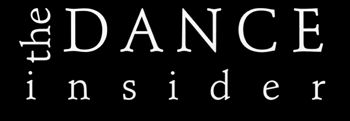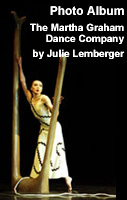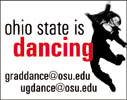











|
Flash Review 1, 11-3:
My Dinner with Billy By Paul Ben-Itzak PARIS -- In American companies, anyway, the ballets of William Forsythe hold a funny place. They're the "wierd" ballets that instantly give a classical ballet company some street cred among the moderns, the young set, and even the intellectuals. You know, they usually appear on a program called "Contemporary Series" or "New Generations." In such a context -- even when surrounded by other "contemporary" work -- their effect can be startling: Forsythe makes ballets that might be called neo-neo-classical, their relation to the rest of the scene being, I imagine, much like what Balanchine's was in his time to that scene, particularly in the 1950s of "Agon." But as much as "neo-classical" is the easiest category in which to place Balanchine, his palette was wide. It's long since been proved that an evening of Balanchine ballets not only won't repeat itself, it is likely to range from neo-classical to classical to clever and, on occasion, even include a stinker. Apropros my evening with Billy and the verve-alicious dancers of the Paris Opera Ballet at the Palais Garnier last night, where an all-Forsythe program opened as the prix set, the question uppermost in my mind was: Could Forsythe sustain interest for an entire evening? Or would what seems startling in a night of, well, other less daring ballets, seem rote by the end of the evening? And how would the dancers survive a whole night of having their limbs pulled and dipped in such arch ways -- and on an incline, no less, dancing as they were on the Palais Garnier's raked stage? Since its premiere at the Garnier in 1987, "In the Middle, Somewhat Elevated" has become a staple of the afore-mentioned contempo programs. When I first saw it in 1993, its effect -- particularly as captured in the scissory, omnipotent body of San Francisco Ballet's Muriel Maffre -- was starting. Of course, I was a ballet neophyte then, so it totally shattered my perception of ballet with its jagged edges, to Thom Willems's jagged music. Agnes Letestu, enacting the same lead role last night, gave a softer, warmer reading to the part. Having seen her last week as Terpsichore in Balanchine's "Apollo" and now in the equally geometrical "Middle," I have to say that Letestu is unique in being able to give warmth to choreographies that on their surface might seem cold. A lot of this is due to her knowing eye contact with the audience. As well, there's the supple way she moves her body, looking comfortable in contortions that most pedestrians would never put their bodies through. Supple and sumptuous also last night, in the same ballet, was Delphine Moussin. I love the way Moussin slithers out of a six-oclock extention, and then into and out of a penchee. Smoothe! Aong the men, Yann Saiz stood out as suitably brawny. (The choreography seems to call on the men at times to comport themselves like studly jocks.) Overall, and not just in these performers, I felt the Paris dancers taking me to a deeper level with this ballet. They journeyed inside its meanings, tapping into its gestalt and not just achieving its physicality. At one point I realized I was zoning out...but then I realized that to this ballet, hypnotically danced by these dancers, this was probably a normal reaction. A few minutes into "Woundwork V," created last year on the POB, I was beginning to sense that the answer to my question, could Forsythe sustain interest for an entire evening, was, er -- no. I was seeing the same arch angles, the same almost Taylor-esque swinging of the arms. The music this time was at one high, eternally starting up, pitch; the women in aborted neo-tutus. Letestu shone, as did that man and woman's man Manuel Legris, a self-effacing partner to Carole Arbo. The latter seemed hard to define, for me anyway; ditto Jose Martinez, who partnered Letestu. Ah, now we get to "The Vertiginous Thrill of Exactitude," which, for some reason, Dance Insiders seem destined to Flash Review about once per month. My colleague Alicia Mosier, catching it on San Francisco Ballet in September with the divine Ms. Tina LeBlanc, loved it; Simone Clifford, considering the Australian Ballet's take on the same, was disturbed by the choreographer's evident mocking commentary on the Schubert music to which the dance is set. (To read their Flashes, just type "Vertiginous" into the search window on our Home Page.) The first time I saw this dance, also on SFB, and also with Ms. LeBlanc, I was perplexed. Mr. Neo-neo seemed to be making a classical tu-tu divertissement; what's up with that? But last night, informed by Simone's observations, he pissed me off! First, the presentation fed into my pre-conceptions that this piece would mock the music by being danced to taped music. TAPED classical music! at the Garnier Opera House!! I got more peeved by the second, as the five dancers, the women arrayed in purple, stiff, disk-like tutus, mugged and over-genuflected (on purpose, I'm sure) for the rest of the ballet. I've nothing against good satire and am not a knee-jerk protectionist of our ballet sacred cows, but this wasn't satire, this was...smugness. Why this ballet has become this year's Forsythe flavor of the month in terms of being programmed by other ballet companies is beyond me; maybe they don't get the joke, and because it's in tutus, they think it's the safest Forsythe ballet, the one least likely to alienate? Well, I'm here to tell you that it alienated me! So much so, that I didn't hold much hope for the evening's finale, "Pas./parts," also created last year on the POB. Could I sit through more of that screechy Thom Willems "music"? Could I stand watching the same neo-neo classical gestures? I was thinking No, he can't hold interest for an entire evening, and he pales next to Balanchine: He may be able to make fun of classical ballet, but Balanchine, modernist as he was, could also whip off a typical classical ballet when the fancy struck him. Despite a promising, portentious beginning, presented by the voluptuous Peggy Grelat, at the beginning of "Pas./parts I still found myself comparing -- this time to Merce Cunningham and his collaborations with John Cage. There was, at times, a similar disassociation with the music. But while these dancers were beautiful, Forsythe didn't seem to me to have the same reservoir of a vocabulary as Cunningham to keep what they were doing interesting. But with Septour, a section for seven dancers, it suddenly all clicked: dancers, dance, and music entered a zone, and took us with them. Willems's score accelerated, and picked up a beat -- a sort of trancey, clubby beat, but still with the minimalist complexity. (Is that a misnomer?!) Willems, who throughout the night had, in each of his previous two pieces, given us more or less one simple and sometimes grating theme, repeated again and again, now busted out, and the dancers, enabled by Forsythe's choreography (or maybe it was the other way around!) busta move. Here a couple of studs emerged from the sea of fleet, droll, and sumptuous women: the animalistic Nicholas Le Riche and the slinky and suave Kader Belarbi. Belarby seems POB's most sinuous and mysterious male dancer, at least that I've seen. He is quite at home with a curving spine. Le Riche, mop of hair tossed about, set the tone in his thunderous, always racing entrances. There was one delicious moment where he leapt downstage (and remember, with the Garnier's raked stage, when we say downstage, we really mean downstage!) and arresed himself in the air for a moment. What was delicious about it was that this moment wasn't delivered with an exclamatin mark, but was almost tossed off, as if it were just one not-so-important part of the symphony -- "but of course." As well, it said something about the self-effacement of this dancer; there was so much going on on stage, there was no guarantee everyone would even catch what he did; but it didn't matter. Writing this now, in fact, I wonder: How many of these moments did I miss? That's the thing: These dancers have incorporated this aesthetic into their bodies so much, as hyper-extended as it often is, they make it seem natural -- at least to their bodies. ...Until finally, at the end, all 15 converge on stage, Forsythe's lighting of the cavernous, bare (except for scrims upstage and stage left, from behind which we sometimes see the dancers' shadows) stage now switches colors more rapidly, as in a club; and, indeed, they are almost like ballet dancers released in a club, who take it over melding the beat-heavy activity of that world with their own highly poised and virtuosic classical expression. And indeed, looking around the Garnier, under the watchful panaromic Chagall painting of twentieth century musical and dance giants that encircles the chandelier, I realized that this was the youngest audience I had so far seen at the Garnier. Most probably younger than me! And as the ballet reached its crescendo, they knew it had arrived at the climax, and the second the curtain started falling on the voguing dancers, the applause erupted, with cheers, and hoots (okay, I was doing a lot of the hooting). It was a dozen curtain calls and much syncopated clapping later before the audience let the dancers -- themselves clearly surprised at this reception -- go home. We've talked a lot in these pages about the question "Is ballet irrelevent?" I don't think we need to jettison the chestnuts to make it relevent. Dancers who take those roles into their twenty-first century bodies and hearts is all it takes to make those stories meaningful to us today. And I also think, as previously noted in my slam of Lionel Hoche's new work for the Opera, that ballet company directors need to apply the same high standard to vetting contemporary work as they do to the classics -- not just acquiring a ballet, or hiring a choreographer, because he or she asks the dancers to do a-typical for ballet things. (As Christopher Bowen commented after seeing Aterbaleto at the United We Dance festival in San Francisco a few years ago, "The problem isn't Billy Forsythe. The problem is all the people who think they're Billy Forsythe." But I think when we have a William Forsythe (or an Angelin Preljocaj, for that matter) in our midst, if we're really serious about attracting new and young audiences to the ballet, we need to elevate the profile of his work in our repertories. That means giving over entire evenings to his ballets, but also sticking his ballets in among a more "classical" evening. (This is the Bill Graham model from the Filmore: You stick the Grateful Dead on the same program as Miles Davis, in the hopes the Dead audience will come back again, even if it's just to see Miles, and vice versa.) We need to convey to these audiences that there's, well, an element of danger and surprise and suspense at the ballet. They can't just go to the "new generations" evening anymore and avoid everything else; they might miss something. I've touted the Garnier's raked stage. Its affect on a Forsythe ballet is, indeed, a thrilling sort of vertigo, as if the dancers are inevitably falling towards us -- there is no turning back. The Paris Opera Ballet clearly knows what time it is, and that there is no turning back. The question is, will American ballet companies go beyond the obligatory single Forsythe ballet, and truly get on board the Forsythe express? If they're serious, I think they need to do this. Part of the reason -- the major reason -- last night worked is that the dancers took Forsythe not just into their bodies, but their spirits, minds, and hearts. Many ballet companies have the physical equipment to handle the choreography's phyiscal demands. But to really go into that zone, and to bring us with them, they need a more vigorous exposure to Forsythe's work. Paris Opera Ballet's William Forsythe spectacle continues at the Palais Garnier through November 11. |
